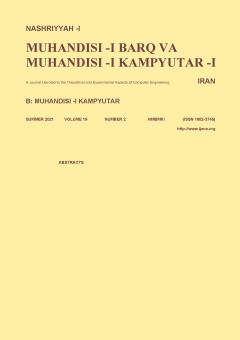A Semi-Central Method to Improve Energy Saving in Real Wireless Sensor Networks Using Clustering and Mobile Sinks
Subject Areas : مهندسی برق و کامپیوترFatemeh Sadeghi 1 , Sepideh Adabi 2 * , Sahar Adabi 3
1 -
2 - Islamic Azad University, North Tehran Branch
3 -
Keywords: Wireless sensor network, energy management, clustering, mobile sink, genetic algorithm,
Abstract :
Applying a hierarchical routing approach based on clustering technique and mobile sink has a great impact on reducing energy consumption in WSN. Two important issues in designing such an approach are cluster head selection and optimal allocation of mobile sinks to critical regions (i.e., regions those have low remaining energy and thus, high risk of energy hole problem). The limited number of mobile sinks should be utilized due to a high cost. Therefore, allocating the limited number of mobile sinks to the high amount of requests received from the critical regions is categorized as a NP-hard problem. Most of the previous studies address this problem by using heuristic methods which are carried out by sensor nodes. However, this type of solutions cannot be implemented in real WSN due to the sensors’ current technology and their limited processing capability. In other words, these are just theoretical solutions. Consequently, a semi-central genetic algorithm based method using mobile sink and clustering technique is proposed in order to find a trade-off between reduction of computation load on the sensors and increasing accuracy. In our method, lightweight computations are separated from heavyweight computations. While, the former computations are carried out by sensors, the latter are carried out by base station. Following activities are done by the authors: 1) cluster head selection by using effective environmental parameters and defining cost function of cluster membership, 2) mathematical modeling of a region’s chance to achieve mobile sink, and 3) designing a fitness function to evaluate the fitness of each allocation of mobile sinks to the critical regions in genetic algorithm. Furthermore, in our activities minimizing the number and length of messages are focused. In summary, the main distinguishing feature of the proposed method is that it can be implemented in real WSN (due to separation of lightweight computations from heavyweight computations) with respect to early mentioned objectives. The simulation results show the better performance of the proposed method compared to comparison bases.
[1] P. Chauhan and P. Ahlawat, "Target tracking in wireless sensor network," International J. of Information & Computation Technology, vol. 4, no. 6, pp. 643-648, Apr. 2014.
[2] F. Fanian and M. Kuchaki Rafsanjani, "A new fuzzy multi-hop clustering protocol with automatic rule tuning for wireless sensor networks," Applied Soft Computing J., vol. 89, pp. 106-115, Apr. 2020.
[3] P. Singh Mehra, M. Najmud Doja, and B. Alam, "Fuzzy-based enhanced cluster head selection (FBECS) for WSN," J. of King Saud University-Science, vol. 32, no. 1, pp. 390-401, Jan. 2020.
[4] S. Adabi, M. Abdolkarimi, and A. Sharifi, "A new multi-objective distributed fuzzy clustering algorithm for wireless sensor networks with mobile gateways," AEU-International J. of Electronics and Communications, vol. 89, pp. 92-104, May 2018.
[5] N. Ghosh, I. Baberjee, and R. Simon Sherratt, "On-demand fuzzy clustering and ant-colony optimization based mobile data collection in wireless sensor network," Wireless Networks, vol. 25, no. 4, pp. 1829-1845, May 2019.
[6] A. Ghosal, S. Halder, and S. K. Das, "Distributed on-demand clustering algorithm for lifetime optimization in wireless sensor networks," J. of Parallel and Distributed Computing, vol. 141, pp. 129-142, Jul. 2020.
[7] T. Stephan, F. Al-Turjman, K. Suresh Joseph, B. Balusamy, and S. Srivastava, "Artificial intelligence inspired energy and spectrum aware cluster based routing protocol for cognitive radio sensor networks," J. of Parallel and Distributed Computing, vol. 142, pp. 90-105, Aug. 2020.
[8] P. Parvin Renold and A. Balaji Ganesh, "Energy efficient secure data collection with path-constrained mobile sink in duty-cycled unattended wireless sensor network," Pervasive and Mobile Computing, vol. 55, pp. 1-12, Apr. 2019.
[9] N. Gharaei, K. Abu bakar, S. Zaiton Mohd Hashim, and A. Hosseingholi Pourasl, "Inter-and intra-cluster movement of mobile sink algorithms for cluster-based networks to enhance the network lifetime," Ad Hoc Networks, vol. 85, pp. 60-70, Mar. 2019.
[10] J. Wang, Y. Yin, J. Zhang, S. Lee, and R. S. Sherratt, "Mobility based energy efficient and multi-sink algorithms for consumer home networks," IEEE Trans. on Consumer Electronics, vol. 59, no. 1, pp. 77-84, Feb. 2013.
[11] S. Gao, H. Zhang, and S. K. Das, "Efficient data collection in wireless sensor networks with path-constrained mobile sinks," IEEE Trans. on Mobile Computing, vol. 10, no. 4, pp. 592-608, Apr. 2011.
[12] M. H. Khodashahi, F. Tashtarian, M. H. Yaghmaee Moghaddam, and M. Tolou Honary, "Optimal location for mobile sink in wireless sensor networks," in Proc IEEE Wireless Communications and Networking Conf., 6 pp., Sydney, Australia, 18-20 Apr. 2010.
[13] M. Marta and M. Cardei, "Improved sensor network lifetime with multiple mobile sinks," Pervasive and Mobile Computing, vol. 5, pp. 542-555, 2009.
[14] M. Elshrkawey, S. M. Elsherif, and M. Elsayed Wahed, "An enhancement approach for reducing the energy consumption in wireless sensor networks," J. of King Saud University-Computer and Information Sciences, vol. 30, no. 2, pp. 259-267, Apr. 2018.
[15] J. Wang, J. Cao, S. Ji, et al., "Energy-efficient cluster-based dynamic routes adjustment approach for wireless sensor networks with mobile sinks," J. of Supercomputing, vol. 73, no. 7, pp. 3277-3290, Jul. 2017.
[16] M. Shokouhifar and A. Jalali, "Optimized sugeno fuzzy clustering algorithm for wireless sensor networks," Engineering Applications of Artificial Intelligence, vol. 60, pp. 16-25, Apr. 2017.

